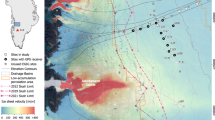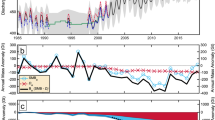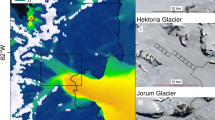Abstract
Mass loss near the ice-sheet margin is evident from remote sensing as frontal retreat and increases in ice velocities. Velocities in the ice sheet interior are orders of magnitude smaller, making it challenging to detect velocity change. Here, we analyze a 35-year record of remotely sensed velocities, and a 6-year record of repeated GPS observations, at the East Greenland Ice-core Project (EastGRIP), located in the middle of the Northeast-Greenland Ice Stream (NEGIS). We find that the shear margins of NEGIS are accelerating, indicating a widening of the ice stream. We demonstrate that the widening of the ice stream is unlikely to be a response to recent changes at the outlets of NEGIS. Modelling indicates that the observed spatial fingerprint of acceleration is more consistent with a softening of the shear margin, e.g. due to evolving fabric or temperature, than a response to external forcing at the surface or bed.
Similar content being viewed by others
Introduction
Ice-sheet mass loss, a primary driver of sea-level rise, is caused by an imbalance between snowfall, melt, and calving. Between 1992 and 2020 the Greenland Ice Sheet lost the equivalent of 13.5 mm of sea-level rise, of which half can be attributed to dynamic mass loss1. The Northeast Greenland Ice Stream (NEGIS) is a prominent ice-flow feature in Greenland. It is the only ice stream that extends into the interior of the ice sheet, initiating less than 150 km from the ice divide. NEGIS drains ~12% of the ice sheet into the Nioghalvfjerdsfjorden (79 N), Zachariæ, and Storstrømmen glaciers2 (Fig. 1). In contrast to other Greenlandic ice streams such as Sermeq Kujalleq (Jakobshavn Isbræ), neither the position nor the width of NEGIS are topographically controlled3. Instead, differences in hydrology or substrate, thermal feedbacks4, or crystal orientation fabric5 may control the shear-margin position. The latter two mechanisms would not impose a fixed ice-stream width, implying that the shear margins may respond to perturbations in flow—forced by changes at the margin, climate, or perhaps geothermal heat flux6. Importantly, all NEGIS outlets have experienced recent, large dynamical changes. Over the last decades, Zachariæ and Nioghalvfjerdsfjorden glaciers have experienced substantial speed ups, and Zachariæ has undergone considerable frontal retreat7,8,9,10. Storstrømmen experienced three large surges during the 20th century and is currently in a quiescent phase, building up towards a new surge11,12. Ice-flow modeling suggests that the retreat at Nioghalvfjerdsfjorden and Zachariæ will continue for at least a century in response to ocean warming13. These dynamical changes at the front will propagate further inland as large-scale ice flow and ice geometry adjust to new boundary conditions. The adjustment will, however, not be instantaneous, and constraining the rate is important for disentangling the different causes of observed changes in ice dynamics with implications for sea-level rise estimates. In this paper, we show how far the adjustment has propagated inland, and how NEGIS velocities are changing in the ice-sheet interior but decoupled from coastal ice-flow dynamics.
Box near EGRIP indicates location of the stake network in Fig. 2. Grid points with less than 10 years of data has been disregarded. The shear margins of the interior are accelerating, indicating that the ice stream is widening. Dashed line shows region of no clear pattern of acceleration separating inland change from frontal changes. Inset shows overview map colored by ice velocity29.
Results
We calculate the acceleration from ice velocity maps spanning the period 1985 to 2018 (Fig. 1). For this we use the ITS_LIVE annual ice-velocity maps14,15 derived from optical feature tracking of Landsat scenes over Greenland. The along-flow acceleration is calculated by separately fitting linear models to the x and y velocities, and then calculating the along-flow component (see online methods 1). We also use GPS observations from a multi-annual measurement campaign in the vicinity of the EastGRIP deep drilling site (75°38′ N, 36°00′ W, 2700 meters above sea level), located on NEGIS in the interior of the ice sheet (Fig. 1). The measurements include a repeated in-situ survey of a strain net consisting of 63 stakes using the Global Positioning System (GPS). The stakes were observed annually15 over the period 2015–2019. We estimate the acceleration at each stake with at least three measurements, while correcting for advective acceleration (see online methods 2)16,17,18.
We observe large dynamical changes at the three major outlets of NEGIS (Zachariæ, 79 N, and Storstrømmen; Fig. 1). We find, in agreement with ref. 7, that recent large dynamical changes at the major outlets of NEGIS (Zachariæ, Storstrømmen, and 79 N) have already propagated ~100 km upstream. Land terminating glaciers in the region appear to be mostly decelerating (Fig. 1), in accordance with physical theory of thinning glaciers. Importantly, our results also show that the inland region of NEGIS is accelerating along the shear margins, indicating that the ice stream is widening (Fig. 1). Although small, the signal is consistent over several hundreds of kilometers—from the onset of the ice stream to ~77°N. We summarize the spatial acceleration pattern by constructing an average profile across the southeastern shear margin (see online methods 1) which greatly improves the signal to noise in the remotely sensed data. This shows that the peak acceleration is just on the inside of the shear margin. Stake observations at EastGRIP also show acceleration (Fig. 2) where sufficient data are available. A single exception is a stake placed in an unusually narrow and deep part of the southern shear margin, where coarse spatial resolution limits the quality of the advective contribution. Further discussion of uncertainties can be found in ref. 15 and online methods 2. The stake accelerations are on the order of a few cm/yr2 (Fig. 2) and generally lie within the uncertainties of the ITS_LIVE14 derived estimates. This is unfortunately not very informative as uncertainties on the remotely sensed accelerations are several tens of cm/yr2 in the region. Given these uncertainties and the difference in temporal coverage, we caution that the comparison should not be taken as validation, but rather as a lack of disagreement.
Modeling can help us distinguish between different expected responses to hypothesized forcing scenarios. We run four different experiments with an idealized model of a 2D cross section of an ice stream to investigate the surface velocity response to changes in the boundary conditions and ice-flow parameters (see online methods 4)19,20,21. Results are consistent with physical theory, but have greater spatial detail: (1) a thicker ice stream flows faster and but, unlike observations, the velocity anomaly is concentrated in the ice-stream interior; (2) increasing the zone of sliding at the base leads to a spatial map of acceleration that peaks just outside the shear margin; and (3) softening the ice column beneath the shear margin leads to an acceleration that peaks just inside the shear margin.
Discussion
The observed widening of the ice stream can either be a response to external forcing or an unforced dynamical instability in the streaming flow. Several kinds of external forcing might explain the observations presented here. E.g., it might be supposed that the interior marginal acceleration of NEGIS is a response to the recent large dynamical changes at the outlets. However, the dynamical response of the outlets and the marginal acceleration are separated by a region with no clear patterns of acceleration (Fig. 1, dashed line). This suggests that the interior widening of NEGIS cannot be due to changes at the front, and any links to the recent marginal acceleration is unlikely. This conclusion is supported by kinematic wave theory22 that leads us to conclude that the signal would be greatly dampened at these distances and would likely be undetectable at EastGRIP (see online methods 3). The ice-stream widening might, instead (or also), be a response to an ongoing slow adjustment of the ice-sheet geometry to changes further in the past, such as the last glacial termination, as geometry controls the large scale flow of ice and hydrological drainage23. Finally, the widening could be a response to recent local changes in climate, such as a trend in accumulation. However, this seems unlikely as accumulation trends in this region are small24, and likely have been small for the past several hundred years25. Our modeling finds that the spatial pattern of acceleration is most consistent with a softening of the ice column beneath the shear margin, rather than changes at the surface or the base. The softening could be facilitated via warming or an evolving fabric. This is unlike the basal mechanisms that have been proposed for the reorganization of ice streams in the Siple coast region of West Antarctica16. Given the additional evidence that the interior part of NEGIS is not topographically steered26, we conjecture that the observed widening of NEGIS is indicative of a dynamical instability in the ice stream.
Further study is needed to understand the mechanism driving the ice-stream widening. A reconstruction of NEGIS frontal fluctuations over the past 45,000 years suggests that relatively large retreats do not have to be associated with large changes in air or ocean temperatures2. This could indicate that NEGIS is very susceptible to even slight changes in forcing2. However, the observations could also be partly explained by unforced dynamical instabilities in the ice stream. Regardless of the cause, our study shows that the ice sheet interior is more dynamically variable than hitherto measured, which has deep implications for the future of the ice sheet. This study therefore raises pressing questions: Why is the ice stream accelerating so deep in the interior? Could NEGIS widening be a pre-cursor to a large-scale reorganization of ice flow in North East Greenland similar to changes in the ice streams at Siple Coast, Antarctica27,28? Our findings highlight the need to understand and carefully separate internal dynamics of ice streams from different forced perturbations and long-term changes in climate forcings. This is crucial if we are to accurately project ice-sheet mass loss in response to recent and future climate change.
Data availability
All source data are available in refs. 14, 15. The derived acceleration can be found at https://doi.org/10.5281/zenodo.6806677.
Code availability
Model code can be found at https://doi.org/10.5281/zenodo.6806513.
References
Fox-Kemper, B. et al. in Climate Change 2021 (eds MassonDelmotte, V. P. et al.) Ch. 9 (Cambridge University Press, 2021).
Larsen, N. K. et al. Instability of the Northeast Greenland ice stream over the last 45,000 years. Nat. Commun. 9, 1872 (2018).
Holschuh, N., Lilien, D. A. & Christianson, K. Thermal weakening, convergent flow, and vertical heat transport in the Northeast Greenland Ice Stream shear margins. Geophys. Res. Lett. 46, 8184–8193 (2019).
Jacobson, H. P. & Raymond, C. E. Thermal effects on the location of ice stream margins. J. Geophys. Res., 103(B6) 12, 111–12,122 (1998).
Minchew, B. M., Meyer, C. R., Robel, A. A., Gudmundsson, G. H. & Simons, M. Processes controlling the downstream evolution of ice rheology in glacier shear margins: case study on Rutford Ice Stream, West Antarctica. J. Glaciol. 64, 583–594 (2018).
Smith-Johnsen, S., de Fleurian, B., Schlegel, N., Seroussi, H. & Nisancioglu, K. Exceptionally high heat flux needed to sustain the Northeast Greenland Ice Stream. Cryosphere 14, 841–854 (2020).
Mouginot, J. et al. Fast retreat of Zachariæ Isstrøm, northeast Greenland. Science 350, 1357–1361 (2015).
Khan, S. A. et al. Sustained mass loss of the Northeast Greenland ice sheet triggered by regional warming. Nat. Clim. Change 4, 292–299 (2014).
Rathmann, N. M. et al. Highly temporally resolved response to seasonal surface melt of the Zachariae and 79N outlet glaciers in northeast Greenland. Geophys. Res. Lett. https://doi.org/10.1002/2017GL074368 (2017).
Lu An, Eric et al. Ocean melting of the Zachariae Isstrøm and Nioghalvfjerdsfjorden glaciers, northeast Greenland. PNAS 118, e2015483118 (2021).
Reeh, N., Bøggild, C. E. & Oerter, H. Surge of Storstrømmen, a large outlet glacier from the inland ice of north‐east Greenland. Gr.ønlands Geologiske Undersøgelses, Rapp. 162, 201–209 (1994).
Mouginot, J., Bjørk, A. A., Millan, R., Scheuchl, B. & Rignot, E. Insights on the surge behavior of Storstrømmen and L. Bistrup Brae, Northeast Greenland, over the last century. Geophys. Res. Lett. 45, 11–197 (2018).
Choi, Y., Morlighem, M., Rignot, E., Mouginot, J. & Wood, M. Modeling the response of Nioghalvfjerdsfjorden and Zachariae Isstrøm Glaciers, Greenland, to ocean forcing over the next century. Geophys. Res. Lett. 44, 071–011,079 (2017).
Gardner, A. S., Fahnestock, M. A.& Scambos, T. A. ITS_LIVE Regional Glacier and Ice Sheet Surface Velocities. https://doi.org/10.5067/6II6VW8LLWJ7 (2019).
Hvidberg, C. S. et al. Surface velocity of the Northeast Greenland Ice Stream (NEGIS): assessment of interior velocities derived from satellite data by GPS. Cryosphere. https://doi.org/10.5194/tc-2020-103 (2020).
Joughin, I., B. Smith, I. Howat, & T. Scambos. MEaSUREs Greenland Ice Sheet Velocity Map from InSAR Data, Version 2. [Indicate subset used]. Boulder, Colorado USA. NASA National Snow and Ice Data Center Distributed Active Archive Center. https://doi.org/10.5067/OC7B04ZM9G6Q (2015).
Salvatier, J., Wiecki, T. V. & Fonnesbeck, C. Probabilistic programming in Python using PyMC3. PeerJ Computer Sci. 2, e55 (2016).
Andersen, J. K., Kusk, A., Boncori, J. P. M., Hvidberg, C. S. & Grinsted, A. Improved ice velocity measurements with Sentinel-1 TOPS interferometry. Remote Sens 12, 2014 (2020).
Rathmann, N. M. & Lilien, D. A. Inferred basal friction and mass flux affected by crystal-orientation fabrics. J. Glaciol. 68, 236–252 (2022).
Thomas, R. E. et al. Microstructure and crystallographic preferred orientations of an azimuthally oriented ice core from a lateral shear margin: Priestley Glacier, Antarctica. Front. Earth Sci. https://doi.org/10.3389/feart.2021.702213 (2021).
Rathmann, N. M. & Lilian D. A. On the nonlinear viscosity of the orthotropic bulk rheology. J. Glaciol. https://doi.org/10.1017/jog.2022.33 (2022).
Williams, C. R., Hindmarsh, R. C. & Arthern, R. J. Frequency response of ice streams. Proc. R. Soc. A 468, 3285–3310 (2012).
Karlsson, N. B. & Dahl-Jensen, D. Response of the large-scale subglacial drainage system of Northeast Greenland to surface elevation changes. Cryosphere 9, 1465–1479 (2015).
Box, J. E. et al. Greenland ice sheet mass balance reconstruction. Part I: net snow accumulation (1600–2009). J. Clim. 26, 3919–3934 (2013).
Karlsson, N. et al. Surface accumulation in Northern Central Greenland during the last 300 years. Ann. Glaciol. 61, 214–224 (2020).
Franke, S. et al. Bed topography and subglacial landforms in the onset region of the Northeast Greenland Ice Stream. Ann. Glaciol. 61, 143–153 (2020).
Bougamont, M. et al. Reactivation of Kamb Ice Stream tributaries triggers century‐scale reorganization of Siple Coast ice flow in West Antarctica. Geophys. Res. Lett. 42, 8471–8480 (2015).
Joughin, I., Tulaczyk, S., Bindschadler, R. & Price, S. F. Changes in West Antarctic ice stream velocities: observation and analysis. J. Geophys. Res.: Solid Earth 107, EPM-3 (2002).
Joughin, I., Smith, B. E. & Howat, I. M. A complete map of Greenland ice velocity derived from satellite data collected over 20 years. J. Glaciol. 64, 1–11 (2018).
Acknowledgements
This work was supported by the Villum Investigator Project IceFlow (16572), a Dancea grant from the Danish Environmental Protection Agency (EPA), and Villum Foundation Experiment grant (2361). EastGRIP is directed and organized by the Physics of Ice, Climate and Earth group, at the Niels Bohr Institute, University of Copenhagen. It is supported by funding agencies and institutions in Denmark (A. P. Møller Foundation, University of Copenhagen), USA (US National Science Foundation, Office of Polar Programs), Germany (Alfred Wegener Institute, Helmholtz Centre for Polar and Marine Research), Japan (National Institute of Polar Research and Arctic Challenge for Sustainability), Norway (University of Bergen and Trond Mohn Foundation), Switzerland (Swiss National Science Foundation), France (French Polar Institute Paul-Emile Victor, Institute for Geosciences and Environmental research), Canada (University of Manitoba) and China (Chinese Academy of Sciences and Beijing Normal University).
Author information
Authors and Affiliations
Contributions
A.G. analyzed data. A.G., C.S.H., D.A.L. and N.M.R. conceived study. A.G., N.M.R., D.A.L. and T.G. modeled ice flow. A.G., C.S.H., N.B.K., H.A.K., P.V. and D.D.J. collected data. All authors interpreted results and wrote paper.
Corresponding author
Ethics declarations
Competing interests
The authors declare no competing interests.
Peer review
Peer review information
Nature Communications thanks the anonymous reviewers for their contribution to the peer review of this work. Peer reviewer reports are available.
Additional information
Publisher’s note Springer Nature remains neutral with regard to jurisdictional claims in published maps and institutional affiliations.
Supplementary information
Rights and permissions
Open Access This article is licensed under a Creative Commons Attribution 4.0 International License, which permits use, sharing, adaptation, distribution and reproduction in any medium or format, as long as you give appropriate credit to the original author(s) and the source, provide a link to the Creative Commons license, and indicate if changes were made. The images or other third party material in this article are included in the article’s Creative Commons license, unless indicated otherwise in a credit line to the material. If material is not included in the article’s Creative Commons license and your intended use is not permitted by statutory regulation or exceeds the permitted use, you will need to obtain permission directly from the copyright holder. To view a copy of this license, visit http://creativecommons.org/licenses/by/4.0/.
About this article
Cite this article
Grinsted, A., Hvidberg, C.S., Lilien, D.A. et al. Accelerating ice flow at the onset of the Northeast Greenland Ice Stream. Nat Commun 13, 5589 (2022). https://doi.org/10.1038/s41467-022-32999-2
Received:
Accepted:
Published:
DOI: https://doi.org/10.1038/s41467-022-32999-2
This article is cited by
-
Shear margins in upper half of Northeast Greenland Ice Stream were established two millennia ago
Nature Communications (2024)
-
Short- and long-term variability of the Antarctic and Greenland ice sheets
Nature Reviews Earth & Environment (2024)
-
Three-dimensional topology dataset of folded radar stratigraphy in northern Greenland
Scientific Data (2023)
-
Crystal orientation fabric anisotropy causes directional hardening of the Northeast Greenland Ice Stream
Nature Communications (2023)
-
Deep-inland thinning of the northeast Greenland glacier predicts fast sea-level rise
Nature (2022)
Comments
By submitting a comment you agree to abide by our Terms and Community Guidelines. If you find something abusive or that does not comply with our terms or guidelines please flag it as inappropriate.





